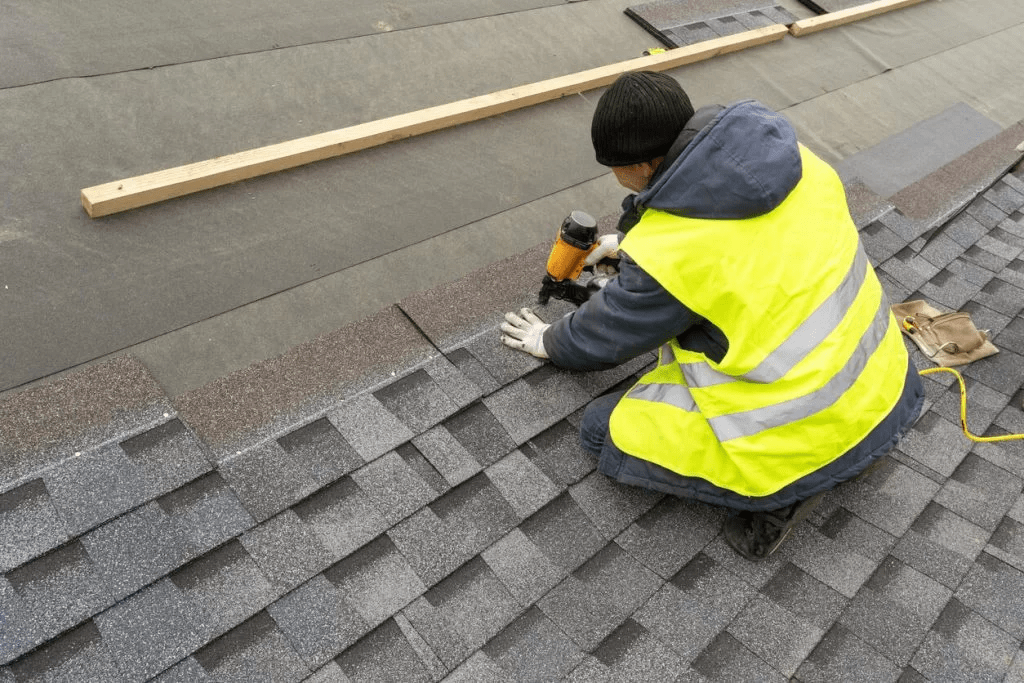Roof shingles are a critical component of your home’s defense against the elements. Installing them correctly ensures longevity, durability, and aesthetic appeal. One crucial factor that significantly impacts the installation process is the temperature. This guide delves into the best temperature to install roof shingles, the reasons behind it, and tips for successful installation.

Why Temperature Matters for Roof Shingles Installation
Roof shingles are designed to be both functional and durable, but their performance can be affected by extreme temperatures. Proper installation is essential to ensure they adhere correctly and provide optimal protection. Understanding the ideal temperature for installation helps in avoiding common problems such as poor adhesion, warping, or premature failure.
Read too: How To Replace Roof Shingles That Blew Off: A Comprehensive Guide
Impact of Temperature on Shingle Installation
- Adhesion: Shingles rely on adhesive strips to bond properly. At too low temperatures, the adhesive may not activate fully, leading to poor bonding.
- Flexibility: Extremely cold temperatures can make shingles brittle and prone to cracking, while high temperatures can cause them to become too soft and susceptible to damage.
- Workability: The ease of handling and cutting shingles is also influenced by temperature. Cold weather can make shingles stiff, while excessive heat can make them too pliable.
Ideal Temperature Range for Installing Roof Shingles
Optimal Temperature Range
The best temperature range for installing roof shingles is typically between 50°F and 85°F (10°C to 29°C). Within this range, shingles maintain the right level of flexibility, and adhesives activate properly to ensure a strong bond. Here’s a breakdown of why this temperature range is ideal:
- 50°F to 70°F (10°C to 21°C): This cooler end of the spectrum allows shingles to remain flexible enough for easy handling and installation. Adhesives activate well within this temperature range, ensuring proper bonding.
- 70°F to 85°F (21°C to 29°C): At this warmer end, shingles are still manageable without becoming overly pliable. The adhesive strips remain effective, and shingles are less likely to suffer from deformation.
Temperature Extremes and Their Effects
Cold Weather Challenges
- Brittleness: Shingles can become brittle and prone to cracking in temperatures below 40°F (4°C). This can lead to issues with proper installation and longevity.
- Adhesive Activation: Cold temperatures can inhibit the activation of adhesive strips, causing shingles to lift or become loose over time.
Hot Weather Challenges
- Softness: In temperatures exceeding 85°F (29°C), shingles may become overly soft. This can cause them to lose their shape or stick to each other before installation is complete.
- Handling Difficulties: High temperatures can make shingles more challenging to handle and position accurately.
Tips for Installing Roof Shingles in Different Temperatures
Cold Weather Installation Tips
- Warm Up Shingles: Store shingles in a warm environment before installation to reduce brittleness. Use a heated space or cover them with blankets to keep them warm.
- Pre-Heat the Roof: Use heaters or heat lamps to warm the roof surface before installing shingles. This helps in activating the adhesive and improving shingle flexibility.
- Handle with Care: Be gentle when handling shingles in cold weather to avoid cracking or damaging them.
Hot Weather Installation Tips
- Early Morning Installation: Begin installation early in the morning to avoid the peak heat of the day. This helps in managing shingle flexibility and reduces heat-related issues.
- Shade and Ventilation: Work in shaded areas or use tarps to protect shingles from direct sunlight. Ensure good ventilation to prevent overheating.
- Cool Storage: Keep shingles in a cool, shaded place to maintain their optimal condition until installation.
How to Monitor Temperature During Installation
- Use a Thermometer: Regularly check the temperature of both the air and the roof surface. This helps in adjusting your installation methods according to current conditions.
- Weather Forecasts: Keep an eye on weather forecasts to plan installation on days with favorable temperatures. Avoid installing during extreme heat waves or cold snaps.
Conclusion
Understanding the best temperature to install roof shingles is crucial for ensuring a durable and effective roofing system. By adhering to the recommended temperature range and implementing the provided tips, you can overcome the challenges posed by extreme weather conditions and achieve a high-quality installation.
Whether you are a professional roofer or a DIY enthusiast, paying attention to temperature conditions will help you avoid common pitfalls and ensure your roof performs optimally for years to come.



Leave a Reply